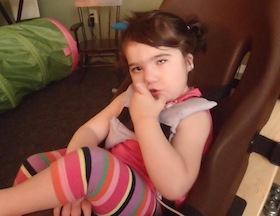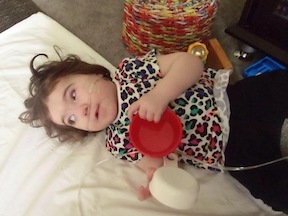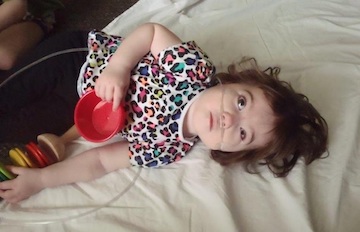Recognizing and Understanding Sensory Loss
Audiences: SPOE, IP, MDT
This unit provides information about combined vision and hearing loss, including risk factors, the diversity of the population, and impact on early development.
Download these slide presentations to find the specific slides referred to on this page:
IN Training Part 1Microsoft PowerPoint Document|2.8 MB PA WebinarMicrosoft PowerPoint Document|5.9 MB
Impact on Early Development
PowerPoint Slides
IN Training (Part 1): Slides 34-36
These slides cover the impact of hearing loss, vision loss, and deaf-blindness.
PA Webinar: Slides 15-24
These slides provide an overview of typical learning versus learning for a student with deaf-blindness and considerations for learning.
Videos
Recorded Presentations
Interventions for Children with Combined Vision and Hearing Loss (Job Aid)
This resource is a bit complicated to get to, but is well worth the effort:
- Go to http://training.eita-pa.org/
- Click on "Log in" in the upper right corner
- If you don't already have an account, scroll to the bottom of the page and click on "Create New Account"
- You will receive an e-mail to confirm your registration
- The link should bring you back to this page: http://training.eita-pa.org/ (if it does not, enter the url into your browser)
- Click on "Interventions for Children with Combined Vision and Hearing Loss (Job Aid)" under "Service Delivery"
- Scroll down and click on the blue "Enroll me" button
- Click on "Interventions for Children with Combined Vision and Hearing Loss 2017-18" with the yellow box next to it
- Begin!
Incidental Learning
PowerPoint Slides
IN Training (Part 1): Slides 38-43
These slides give an overview of incidental learning.
Photos

Overview of Deaf-Blindness
PowerPoint Slides
IN Training (Part 1): Slides 1-23
These slides provide an overview of deaf-blindness–identifying children, risk factors, conditions, and signs and symptoms.
PA Webinar: Slides 1-17
These slides cover the definition of deaf-blindness, etiologies, and prevalence.
Identifying and Supporting Young Children with Combined Vision and Hearing Loss: Slides
PowerPoint from a webinar presented by Megan Cote, Carol Darrah, and Emma Nelson for CEC's Division for Early Childhood on 1/18/17.
Recorded Presentations
PA Webinar: Intro Section
This is the introduction to a webinar presented by Megan Cote, Carol Darrah, and Emma Nelson for Part C providers and coordinators in Pennsylvania (3:04).
PA Webinar: Definitions, Etiology, and Prevalence Section
Megan Cote provides the definition of deaf-blindness as well as an overview of etiologies, diversity, population, and prevalence of children with deaf-blindness (6:10).
PA Webinar: Considerations for Learning Section
Carol Darrah gives an overview of typical learning versus the learning of children with deaf-blindness (9:54).
Identifying and Supporting Young Children with Combined Vision and Hearing Loss: Recording
This webinar was presented by Megan Cote, Carol Darrah, and Emma Nelson for CEC's Division for Early Childhood on 1/18/17.
Photos



Prematurity, Ongoing Medical Issues, and Multiple Disabilities
PowerPoint Slides
IN Training (Part 1): Slides 24-32
These slides cover the implications of prematurity, ongoing medical issues, and multiple disabilities.
Handouts
Combined Vision and Hearing Loss: Implications of Prematurity
This four-page factsheet from the Indiana Deaf-Blind Services Project is useful for both service providers and families.
Risk Factors
PowerPoint Slides
In Training (Part 1): Slides 6-23
Please view slides 6-23. These slides cover identification of children with deaf-blindness, risk factors, and signs and symptoms.
Handouts
Risk Factors for Combined Vision and Hearing Loss
A list of conditions and syndromes that are associated with vision/hearing loss.
Signs, Symptoms, & Risk Factors
Pages 3–6 of this document from Washington Sensory Disabilities Services cover symptoms and risk factors associated with vision and hearing loss in young children and list vision- and hearing-related developmental milestones.
Vision and Hearing - A List of Who's Who
This one-page factsheet briefly describes the roles of various vision and hearing professionals.
ICD-10 Codes
A list of etiologies related to sensory loss with corresponding medical billing codes. Useful for states with diagnoses that automatically qualify a child for Part C services.
Participant Learning
Activity 1:
Take an infant or toddler's medical records and using the risk factors lists and the ICD-10 codes, determine whether the child might be considered deaf-blind. Then, locate and contact your state deaf-blind project to talk about potential referral.
Activity 2:
Think about a child you know. That child has an identified vision OR hearing loss. After doing a home visit, you suspect that the child really has a combined vision AND hearing loss. Think about when and how you would talk to the family about the possible dual loss. Is your approach different based upon which type of additional loss you suspect?
Reflection:
Think about the impact on the family quality of life and list concerns that may need to be addressed in the IFSP as well as resources you may want to provide.
Activity 3:
Describe incidental learning in your own words. How does a combined vision and hearing loss affect a child's incidental learning? What kind of direct learning experiences would help the child learn about the objects, people, and activities in their environment?
